Solutions to 2004 Monthly Questions

Solution to January 2004 Question of the Month
The question was:
In a recent issue of The Astrophysical Journal(598:700-703, 2003 November 20), the authors used experiments
to simulate the upper atmosphere of Titan (moon of Saturn) and reported that
oxirane (also named ethylene oxide) is its main oxygenated hydrocarbon product. Previous theory had predicted methanol and formaldehyde to be the main compounds of that type.
The discovery is not a complete shock because oxirane has been detected in the interstellar medium and hot molecular cloud cores.
The first opportunity to detect it in Titan will occur in January, 2005 during the entry of
the Huygens probe into the satellite's atmosphere.
Its formula is C2H4O.
Can you come up with three possible structural formulas for this compound?
Solution:
One possibility is acetaldehyde H3C-C(H)=O 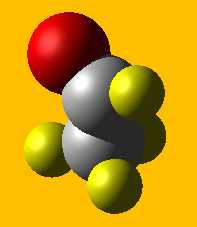 , but that's not the one.
The diagram below shows two other possibilities
, but that's not the one.
The diagram below shows two other possibilities
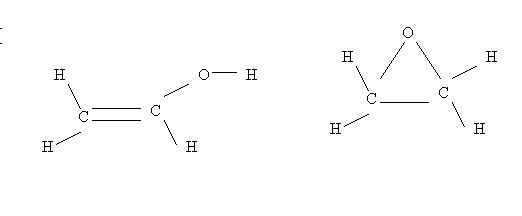
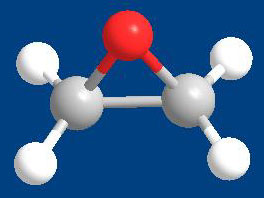
and the one on the right is oxirane. For more information on NASA's
mission to Titan visit the JPL web site
Also check out this link
Solution to February 2004 Question of the Month
The question was:
Prebiotic earth also had oxygen. But as the electron scavenger reacted with metals,
it eventually disappeared from our atmosphere. To this date most of those oxygen atoms remain
bonded to iron, aluminum and other metals. The oxygen that is now in our air was released from H2O
only after blue-green algae evolved.
When the metal europium was exposed to earth's early oxygen-atmosphere, it reacted to form compounds containing
europium's most oxidized state Eu+3.
According to accepted theory, the moon was once part of
the earth, and its rocks and ours were one when all the oxidation occurred. Yet when feldspar minerals from the moon
were analysed, geologists found a surprising amount of Eu+2. This suggested that
Eu+2-containing compounds formed in an atmosphere with little or no oxygen.
How can this be?
Solution:
The moon formed after a large body struck the earth. The debris from the giant impact
then orbited the earth, coalesced and gathered more material from other impacts before forming our present large satellite.
The Eu+2 is either from the original body that hit the earth or from the additional extraterrestrial material.
References:
Emsley, John. Nature's Building Blocks. Oxford University Press. 2001
Solution to March 2004 Question of the Month
The question was:
There are two samples of 30% alcohol on your counter top. Both contain C2H6O
and water; yet one is a product of fermentation and distillation, while the other sample's alcohol
was artificially produced by treating ethylene gas with 98% sulfuric acid and then heated in the presence
of water. How do you tell the two alcohol-samples apart? (Note that ethylene itself is produced by cracking
petroleum with hot steam.)
Solution:
During the millions of years that it took to form at the bottom of the seas,
petroleum lost its radioactive form of carbon, carbon 14.
On the other hand, some of the carbon in the yeast-produced alcohol will still contain the isotope. Strangely,
then, the natural form of alcohol is slightly radioactive(not in harmful amounts); the artificial form is not.
References:
Emsley, John. Nature's Building Blocks. Oxford University Press. 2001
Morrison, Robert and Boyd, Robert. Organic Chemistry. 3rd Edition. Allyn and Bacon. 1973
Solution to April 2004 Question of the Month
The question was:
 |
My wife left a solution in the fridge for about a year. Some water slowly evaporated, leaving some of
the solute to crystallize. My photograph of the crystal is shown in figure 3. Figure 2 is an electron
micrograph of the same type of crystals, and figure 1 reveals the hydrogen bonding between different
molecules of the solute.
Notice how the same geometric arrangement exists regardless of the scale of magnification.
Can you identify the solute? |
Solution: Table sugar = sucrose = C12H22O11.
Solution to May 2004 Question of the Month
The question was:
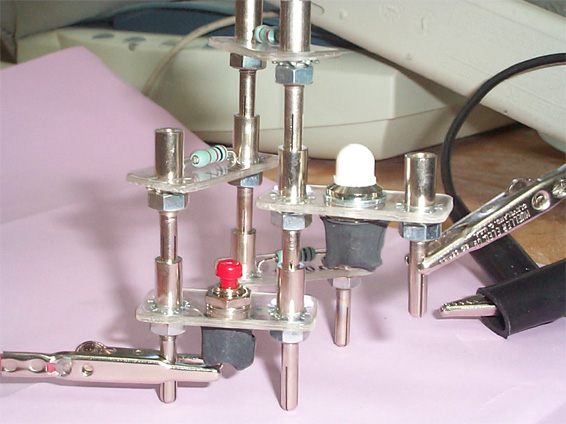
This was a student's idea.(Joshua Ghoddoussi) How does the
switch convert a series circuit into parallel one, therefore increasing the voltage and current for the light bulb?
Draw the circuit to show what is going on.
Solution:

Before pushing the button, the current is forced through
2 resistors and then through the light bulb. The overall resistance and the current is too low to illuminate the bulb.
When the button is pushed down, it opens up another option for the current; we have a "parallel" circuit with
the bulb experiencing the full voltage and therefore more current. The other "branch" with the 2 resistors does not
experience any current because the path with the switch is a "short", one of no resistance prior to the bulb.
Solution to June 2004 Question of the Month
The question was:
The seed to this question was planted by student Chris Galatas. Let's say you place 100 g of reactants in
a shatter-proof reaction vessel and carry it to the edge of a cliff 1000 m above the ocean.
You attach it to a little parachute and drop it so that the drag eliminates most of the vessel's kinetic energy.
By the time the reactants have hit the ocean, will they have reacted faster than if they had remained
on top of the cliff? Explain. What is the difference between chemical potential energy and gravitational
potential energy?
Solution:
No. Gravitational potential energy is mgh, where m = mass of the object; g = gravitational acceleration
and h= height of the object above the surface. This energy is not accessible to the reacting molecules
and is not part of their enthalpy which includes internal energy(kinetic and mostly bond energies). If,
however, the reaction vessel made a significant impact upon falling (gravitational potential energy being converted into
kinetic energy) then that energy could supply the activation energy for the reaction. But the parachute consumes the 1 kJ
(not much! That of course ignores the mass of the vessel itself)of gravitational potential energy, so the reaction will
not occur faster.
Solution to July 2004 Question of the Month
The question was:

Galaxies that are closer to earth are not receding from us as fast as those that are further away.
What drawing and simple calculation can you use to convince yourself that this is the case?
Solution:
For simplicity's sake, let's assume that the universe doubled in size from one moment in time to another.
This implies, as shown in the diagram, that its radius doubles. We are at position 1 originally, and we
move to position 1'. Similarly a galaxy originally at position 2 moves to 2', and so on.
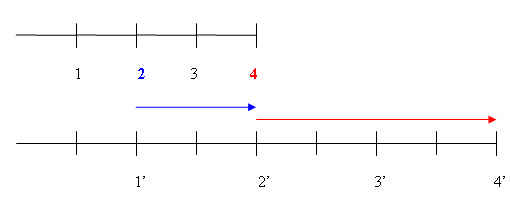
In one unit of time, galaxy 2 has moves two units, but galaxy 3 has moved three units
and galaxy four has moved four units.
So clearly those galaxies that are further away are receding faster.
For a more detailed exploration of this topic, click 
Solution to August 2004 Question of the Month
The question was:
Sure, the formulas for momentum and kinetic energy are not the same, but since
both involve a product of mass and velocity, how do you picture the difference between them?
Solve the following problem to shine a new light on the two concepts:
A 1.0 X 103 kg car is moving at 22 m/s(about 79 km/h since every m/s = 3.6 km/h).
Suppose that an average of force of 1.5 X104N is needed to bring the car to a
complete stop.
What practical information can we obtain by calculating the car's change in
momentum? From its change in kinetic energy?
Solution:
The change in momentum = Dp = 0 - mv
= -1.0 X 103 kg(22 m/s)= -22 000 Ns
The change in momentum is equivalent to impulse, which in this case is the product of
the braking force and the the braking time.
D p = FDt.
D t = Dp/F = -22000Ns/1.5 X104N
D t = 1.5 s is the time it takes for the car to come to a stop.
The change in kinetic energy is = DEk =
0 - 0.5mv2= 0.5(A 1.0 X 103 kg)(22 m/s)2 = -242 000 J.
This change in kinetic energy is also the product of force and distance.
In other words, along with the braking force, the kinetic energy change reveals the breaking distance. Dx.
DEk = F Dx
Dx = -242000J/1.5 X104N = 16.1 m.
When two objects collide elastically, kinetic energy and momentum are both conserved.
This can lead to interesting relationships which played a key role in
Chadwick's discovery of the neutron.
Solution to September 2004 Question of the Month
The question was:
Buoyancy is a neat topic that is somehow left out of many high school and CEGEP
physics courses. A man dives into a deep pool wearing a lightweight harness. At the bottom of the pool,
he attaches himself to a rope leading to a spring balance above the surface of the pool.
Because of water's buoyant force(a simple product of gravity and the mass of displaced water), the
balance records only 33 N of weight. His actual mass(harness included) is 70.0 kg.
What is the man's density?
Solution:
Real weight - buoyant force = apparent weight.
70.0kg(9.8m/s2) N - buoyant force = 33 N.
buoyant force = 70(9.8) - 33 = 653 N.
But the buoyant force is just a product of gravity and the mass of displaced water:
653= m(9.8)
m = 66.7 kg of water were displaced by the man.
The volume of water = the man's volume:
volume of water = mass/density =66.7 kg/(1000kg/m3)
= 0.0667 m3.
density of man = mass/volume = 70.0 kg/0.0667m3 =1.05 X 103 kg/m3.
If you think about it, the same approach applies to one's true weight in air.
When you step on a bathroom scale, your true weight is actually being reduced by the slight buoyant
force of air. Let's take the same 70.0 kg man as an example. His volume of 0.0667 m3implies
a buoyant force of 0.0667 m3*density of air in kg/m3*9.8m/s2.
At 101.3 kPa and 20.0 oC,
air has a density of n/V = P/RT=101.3kPa/(8.31 LkPa/(K mole))/(20 + 273 K)=
0.0416 moles/L.
Now we need to convert this to kg/m3.
=0.0416 moles/L(29.3 g/mole)(kg/1000g)(1000L/m3)= 1.219 kg/m3.
(note that to obtain air's avg.molar mass we take a weighted average of its two main components' molar
masses: 78%
nitrogen and 21% oxygen)
buoyant force = 0.0667 m3* 1.219kg/m3*9.8m/s2= 0.80 N
So the man's true weight is 0.80 N higher, not that significantly higher. It is equivalent to only
0.80 N/9.8m/s2 = 0.082 kg or 82 g.
For another playful buoyancy problem, see #3 in this review exercise.
Solution to October 2004 Question of the Month
The question was:
A cylinder contains 40. g of He. The gas occupies a volume of 256 ml.
What if we had an identical cylinder with a piston exerting the same pressure on 40 g of Xe--- what volume
would the Xe gas occupy at the same temperature? Xe atoms are 2.4 times as wide as those of He.
Solution:
The size of the gaseous atoms is irrelevant. According to Avogadro's Law,
the volume will be proportional to the number of moles of any ideal gas. Since 40g of He represents 10 moles,
and 40 g of Xe is only 0.31 moles, then the Xe will only occupy (0.31/10)*256 ml = 7.9 ml.
Solution to November 2004 Question of the Month
The question was:
Adding sodium to water can turn into a hazardous adventure. Adding this reactive alkali metal
to ice can get even more dangerous. Why? Shouldn't cooling the reaction slow it down?
Solution:
Initially, because of the colder temperature, the reaction is deceptively calmer.
But as it finally begins to react, the heat of reaction causes the remaining sodium to sink into the ice.
The hydrogen gets temporarily trapped within the ice, resulting in a sudden increase in pressure. With this reaction,
I've managed to shatter glass containers, and worse, I've created a dangerous fireworks-like display of
flying sodium fragments.
Solution to December 2004 Question of the Month
The question was:
Here is another question based on a demonstration. If methanol is carefully added to concentrated sulfuric
acid, two layers are created. If a few crystals of KMnO4 are then added to the heterogeneous mixture,
a nice exothermic redox reaction occurs at the interface, where the two liquids meet. Small fireworks result, and a great deal of heat is released.
If you stir, the reaction can cause more fireworks or possibly ignite the methanol.
Once the methanol burns, you can colour the flame with various salts..
So we added a potassium salt to render the flame violet(because of K+1).
We not only saw a violet flame but red sparks, and eventually a purple gas was released.
Why did a purple gas
appear? Why red sparks?
Solution:
The purple gas was iodine. It formed because the potassium salt contained iodate, IO3-1.
In the presence of leftover methanol(CH4O)and concentrated acid, IO3-1acts as an oxidixing agent,
and so, in stealing electrons
it is itself reduced to I2:
6 H+ + 6 IO3- + 5 CH4O ->
5 CO2 + 3 I2 + 13 H2O
The prior red sparks could have come from a manganese salt that was produced by the permanganate,MnO4-.
In another related demonstration we added zinc oxide to burning methanol.
We witnessed a bedazzling display of fireworks, as revealed by the pictures below. What surprised me is, as far as I know from
what I read on the subject, ZnO is not a common ingredient of fireworks.
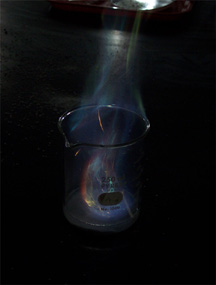
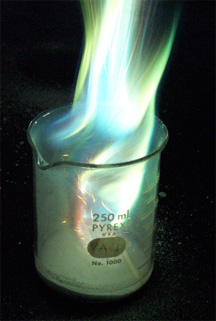
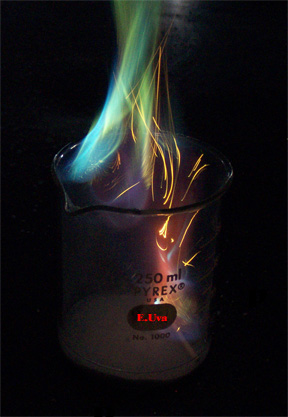
ZnO Movie(filmed by A. Korkidakis)
Page Maintained by E. Uva;
euva@retired.ca
Copyright ©2004







 , but that's not the one.
The diagram below shows two other possibilities
, but that's not the one.
The diagram below shows two other possibilities 









